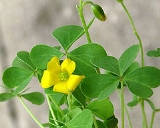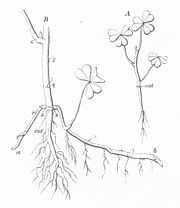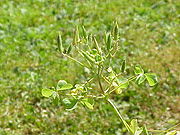
Oxalis stricta
Encyclopedia
Oxalis stricta, called the common yellow woodsorrel (or simply yellow woodsorrel), common yellow oxalis, upright yellow-sorrel, lemon clover, or more ambiguously and informally "sourgrass" or "pickle plant", is an herbaceous
plant
native
to North America
, parts of Eurasia
, and has a rare
introduction in Britain
. It tends to grow in woodland
s, meadows, and in disturbed areas as both a perennial and annual
. Erect when young, this plant
later becomes decumbent as it lays down, and branches regularly. It is not to be confused with similar plants which are also often referred to as "yellow woodsorrel".
of gardens, fields
, and lawn
s, it grows in full sun
or shade. The alternate leaves
of this plant
are divided into three heart
-shaped leaflets (a typical trait of other species
of Oxalis
) that can grow up to 2 cm wide. These leaves curl up at night
(exhibiting nyctinasty
), and open in the day
to perform photosynthesis
. The mature seed
capsules open explosively when disturbed (a very similar trait to that of the mature seed capsules or fruits of plants found in the genus Impatiens
) and can disperse seeds up to 4 meters (about 13 feet) away. The flowers of the plant are hermaphroditic, blooming
from July to October.
O. stricta generally requires dry or moist
, alkaline soils, preferring sand
y and loamy dirt to grow in. It requires well-drained soil and can grow in nutritionally poor grounds. It does not do well in shade.
 All parts of the plant are edible, with a distinct tangy flavor
All parts of the plant are edible, with a distinct tangy flavor
(as is common in all plants in the genus Oxalis
).
 The leaves and flowers of the plant are sometimes added to salads for decoration and flavoring. These can also be chewed raw (along with other parts of the plant, but not the root
The leaves and flowers of the plant are sometimes added to salads for decoration and flavoring. These can also be chewed raw (along with other parts of the plant, but not the root
) as a thirst
quencher. The green pods
are pleasant raw, having a juicy crisp texture and a tartness similar to rhubarb in flavour.
The leaves can be used to make a flavored drink
that is similar in taste to lemonade
, and the whole plant can be brewed
as a tisane
that has an aroma somewhat like that of cooked green beans.
The juices of the plant have been extracted from its greens as a substitute to common vinegar
.
Oxalis stricta contains large amounts of vitamin c
.
dye
can be obtained by boiling the whole plant.
of the plant has been used to treat swellings
.
Herbaceous
A herbaceous plant is a plant that has leaves and stems that die down at the end of the growing season to the soil level. They have no persistent woody stem above ground...
plant
Plant
Plants are living organisms belonging to the kingdom Plantae. Precise definitions of the kingdom vary, but as the term is used here, plants include familiar organisms such as trees, flowers, herbs, bushes, grasses, vines, ferns, mosses, and green algae. The group is also called green plants or...
native
Indigenous (ecology)
In biogeography, a species is defined as native to a given region or ecosystem if its presence in that region is the result of only natural processes, with no human intervention. Every natural organism has its own natural range of distribution in which it is regarded as native...
to North America
North America
North America is a continent wholly within the Northern Hemisphere and almost wholly within the Western Hemisphere. It is also considered a northern subcontinent of the Americas...
, parts of Eurasia
Eurasia
Eurasia is a continent or supercontinent comprising the traditional continents of Europe and Asia ; covering about 52,990,000 km2 or about 10.6% of the Earth's surface located primarily in the eastern and northern hemispheres...
, and has a rare
Rare species
A rare species is a group of organisms that are very uncommon or scarce. This designation may be applied to either a plant or animal taxon, and may be distinct from the term "endangered" or "threatened species" but not "extinct"....
introduction in Britain
Great Britain
Great Britain or Britain is an island situated to the northwest of Continental Europe. It is the ninth largest island in the world, and the largest European island, as well as the largest of the British Isles...
. It tends to grow in woodland
Woodland
Ecologically, a woodland is a low-density forest forming open habitats with plenty of sunlight and limited shade. Woodlands may support an understory of shrubs and herbaceous plants including grasses. Woodland may form a transition to shrubland under drier conditions or during early stages of...
s, meadows, and in disturbed areas as both a perennial and annual
Annual plant
An annual plant is a plant that usually germinates, flowers, and dies in a year or season. True annuals will only live longer than a year if they are prevented from setting seed...
. Erect when young, this plant
Plant
Plants are living organisms belonging to the kingdom Plantae. Precise definitions of the kingdom vary, but as the term is used here, plants include familiar organisms such as trees, flowers, herbs, bushes, grasses, vines, ferns, mosses, and green algae. The group is also called green plants or...
later becomes decumbent as it lays down, and branches regularly. It is not to be confused with similar plants which are also often referred to as "yellow woodsorrel".
Growth
Commonly considered a weedWeed
A weed in a general sense is a plant that is considered by the user of the term to be a nuisance, and normally applied to unwanted plants in human-controlled settings, especially farm fields and gardens, but also lawns, parks, woods, and other areas. More specifically, the term is often used to...
of gardens, fields
Field (agriculture)
In agriculture, the word field refers generally to an area of land enclosed or otherwise and used for agricultural purposes such as:* Cultivating crops* Usage as a paddock or, generally, an enclosure of livestock...
, and lawn
Lawn
A lawn is an area of aesthetic and recreational land planted with grasses or other durable plants, which usually are maintained at a low and consistent height. Low ornamental meadows in natural landscaping styles are a contemporary option of a lawn...
s, it grows in full sun
Sun
The Sun is the star at the center of the Solar System. It is almost perfectly spherical and consists of hot plasma interwoven with magnetic fields...
or shade. The alternate leaves
Leaves
-History:Vocalist Arnar Gudjonsson was formerly the guitarist with Mower, and he was joined by Hallur Hallsson , Arnar Ólafsson , Bjarni Grímsson , and Andri Ásgrímsson . Late in 2001 they played with Emiliana Torrini and drew early praise from the New York Times...
of this plant
Plant
Plants are living organisms belonging to the kingdom Plantae. Precise definitions of the kingdom vary, but as the term is used here, plants include familiar organisms such as trees, flowers, herbs, bushes, grasses, vines, ferns, mosses, and green algae. The group is also called green plants or...
are divided into three heart
Heart (symbol)
The heart has long been used as a symbol to refer to the spiritual, emotional, moral, and in the past, also intellectual core of a human being...
-shaped leaflets (a typical trait of other species
Species
In biology, a species is one of the basic units of biological classification and a taxonomic rank. A species is often defined as a group of organisms capable of interbreeding and producing fertile offspring. While in many cases this definition is adequate, more precise or differing measures are...
of Oxalis
Oxalis
Oxalis is by far the largest genus in the wood-sorrel family Oxalidaceae: of the approximately 900 known species in the Oxalidaceae, 800 belong here...
) that can grow up to 2 cm wide. These leaves curl up at night
Night
Night or nighttime is the period of time when the sun is below the horizon. This occurs after dusk. The opposite of night is day...
(exhibiting nyctinasty
Nyctinasty
Nyctinasty is the circadian rhythmic nastic movement of higher plants in response to the onset of darkness. Examples are the closing of the petals of a flower at dusk and the sleep movements of the leaves of many legumes....
), and open in the day
Day
A day is a unit of time, commonly defined as an interval equal to 24 hours. It also can mean that portion of the full day during which a location is illuminated by the light of the sun...
to perform photosynthesis
Photosynthesis
Photosynthesis is a chemical process that converts carbon dioxide into organic compounds, especially sugars, using the energy from sunlight. Photosynthesis occurs in plants, algae, and many species of bacteria, but not in archaea. Photosynthetic organisms are called photoautotrophs, since they can...
. The mature seed
Seed
A seed is a small embryonic plant enclosed in a covering called the seed coat, usually with some stored food. It is the product of the ripened ovule of gymnosperm and angiosperm plants which occurs after fertilization and some growth within the mother plant...
capsules open explosively when disturbed (a very similar trait to that of the mature seed capsules or fruits of plants found in the genus Impatiens
Impatiens
Impatiens is a genus of about 850–1,000 species of flowering plants, widely distributed throughout the Northern Hemisphere and tropics. Together with the puzzling Hydrocera triflora, this genus makes up the family Balsaminaceae...
) and can disperse seeds up to 4 meters (about 13 feet) away. The flowers of the plant are hermaphroditic, blooming
Blossom
In botany, blossom is a term given to the flowers of stone fruit trees and of some other plants with a similar appearance that flower profusely for a period of time in spring...
from July to October.
O. stricta generally requires dry or moist
Moisture
Humidity is the amount of moisture the air can hold before it rains. Moisture refers to the presence of a liquid, especially water, often in trace amounts...
, alkaline soils, preferring sand
Sand
Sand is a naturally occurring granular material composed of finely divided rock and mineral particles.The composition of sand is highly variable, depending on the local rock sources and conditions, but the most common constituent of sand in inland continental settings and non-tropical coastal...
y and loamy dirt to grow in. It requires well-drained soil and can grow in nutritionally poor grounds. It does not do well in shade.
Culinary uses

Flavor
Flavor or flavour is the sensory impression of a food or other substance, and is determined mainly by the chemical senses of taste and smell. The "trigeminal senses", which detect chemical irritants in the mouth and throat as well as temperature and texture, are also very important to the overall...
(as is common in all plants in the genus Oxalis
Oxalis
Oxalis is by far the largest genus in the wood-sorrel family Oxalidaceae: of the approximately 900 known species in the Oxalidaceae, 800 belong here...
).

Root
In vascular plants, the root is the organ of a plant that typically lies below the surface of the soil. This is not always the case, however, since a root can also be aerial or aerating . Furthermore, a stem normally occurring below ground is not exceptional either...
) as a thirst
Thirst
Thirst is the craving for fluids, resulting in the basic instinct of animals to drink. It is an essential mechanism involved in fluid balance. It arises from a lack of fluids and/or an increase in the concentration of certain osmolites, such as salt...
quencher. The green pods
Fruit
In broad terms, a fruit is a structure of a plant that contains its seeds.The term has different meanings dependent on context. In non-technical usage, such as food preparation, fruit normally means the fleshy seed-associated structures of certain plants that are sweet and edible in the raw state,...
are pleasant raw, having a juicy crisp texture and a tartness similar to rhubarb in flavour.
The leaves can be used to make a flavored drink
Drink
A drink, or beverage, is a liquid which is specifically prepared for human consumption. In addition to fulfilling a basic human need, beverages form part of the culture of human society.-Water:...
that is similar in taste to lemonade
Lemonade
Lemonade is a lemon-flavored drink, typically made from lemons, water and sugar.The term can refer to three different types of beverage:...
, and the whole plant can be brewed
Steeping
Steeping or weltering may mean:# Saturation in a liquid solvent to extract a soluble ingredient, where the solvent is the desired product. Tea is prepared for drinking by steeping the leaves in heated water to release the flavor and nutrients...
as a tisane
Tisane
A herbal tea, tisane, or ptisan is a herbal or plant infusion and usually not made from the leaves of the tea bush . Typically, herbal tea is simply the combination of boiling water and dried fruits, flowers or herbs. Herbal tea has been imbibed for nearly as long as written history extends...
that has an aroma somewhat like that of cooked green beans.
The juices of the plant have been extracted from its greens as a substitute to common vinegar
Vinegar
Vinegar is a liquid substance consisting mainly of acetic acid and water, the acetic acid being produced through the fermentation of ethanol by acetic acid bacteria. Commercial vinegar is produced either by fast or slow fermentation processes. Slow methods generally are used with traditional...
.
Oxalis stricta contains large amounts of vitamin c
Vitamin C
Vitamin C or L-ascorbic acid or L-ascorbate is an essential nutrient for humans and certain other animal species. In living organisms ascorbate acts as an antioxidant by protecting the body against oxidative stress...
.
Practical uses
An orangeOrange (colour)
The colour orange occurs between red and yellow in the visible spectrum at a wavelength of about 585–620 nm, and has a hue of 30° in HSV colour space. It is numerically halfway between red and yellow in a gamma-compressed RGB colour space, the expression of which is the RGB colour wheel. The...
dye
Dye
A dye is a colored substance that has an affinity to the substrate to which it is being applied. The dye is generally applied in an aqueous solution, and requires a mordant to improve the fastness of the dye on the fiber....
can be obtained by boiling the whole plant.
Medicinal uses
A poulticePoultice
A poultice, also called cataplasm, is a soft moist mass, often heated and medicated, that is spread on cloth over the skin to treat an aching, inflamed, or painful part of the body. It can be used on wounds such as cuts...
of the plant has been used to treat swellings
Swelling (medical)
In medical parlance, swelling is the transient enlargement or protuberance in the body and may include tumors. According to cause, it may be congenital, traumatic, inflammatory, neoplastic or miscellaneous....
.

